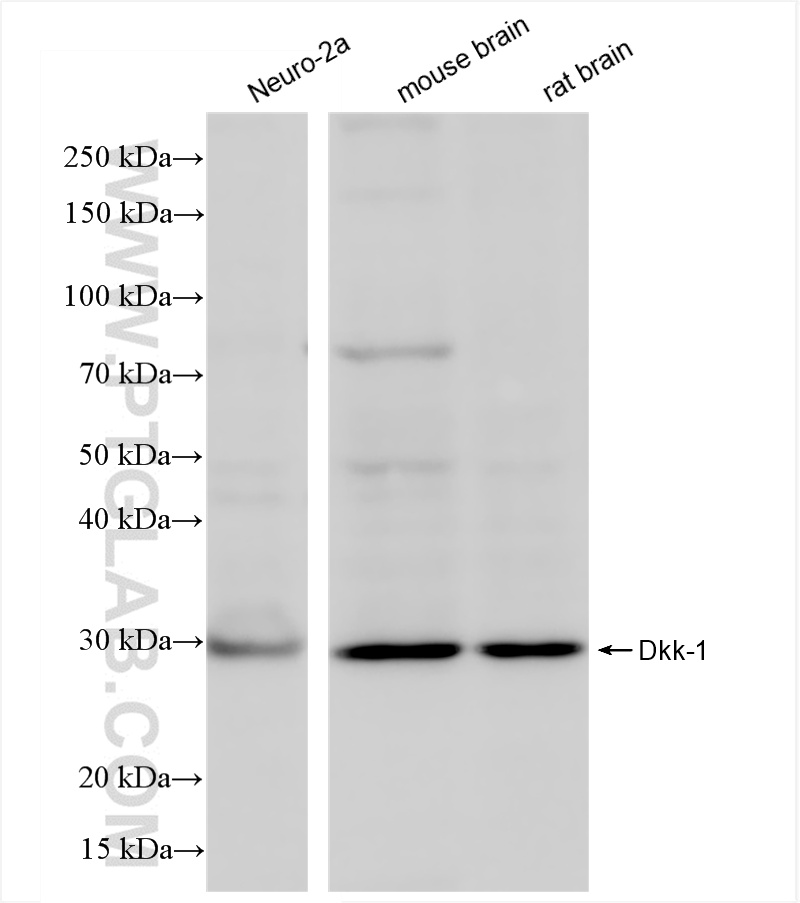验证数据展示
经过测试的应用
| Positive WB detected in | Neuro-2a cells, mouse brain tissue, rat brain tissue |
推荐稀释比
| 应用 | 推荐稀释比 |
|---|---|
| Western Blot (WB) | WB : 1:1000-1:4000 |
| It is recommended that this reagent should be titrated in each testing system to obtain optimal results. | |
| Sample-dependent, Check data in validation data gallery. | |
产品信息
86207-1-RR targets DKK1 in WB, ELISA applications and shows reactivity with mouse, rat samples.
| 经测试应用 | WB, ELISA Application Description |
| 经测试反应性 | mouse, rat |
| 免疫原 |
CatNo: Eg4649 Product name: Recombinant Mouse DKK1 protein (rFc Tag) Source: mammalian cells-derived, pHZ-KIsec-N-rFc Tag: N-rFc Domain: 32-272 aa of NM_010051.3 Sequence: TLNSVLINSNAIKNLPPPLGGAGGQPGSAVSVAPGVLYEGGNKYQTLDNYQPYPCAEDEECGSDEYCSSPSRGAAGVGGVQICLACRKRRKRCMRHAMCCPGNYCKNGICMPSDHSHFPRGEIEESIIENLGNDHNAAAGDGYPRRTTLTSKIYHTKGQEGSVCLRSSDCAAGLCCARHFWSKICKPVLKEGQVCTKHKRKGSHGLEIFQRCYCGEGLACRIQKDHHQASNSSRLHTCQRH 种属同源性预测 |
| 宿主/亚型 | Rabbit / IgG |
| 抗体类别 | Recombinant |
| 产品类型 | Antibody |
| 全称 | dickkopf homolog 1 (Xenopus laevis) |
| 别名 | Dickkopf-1, Dickkopf-related protein 1, DKK 1, Dkk-1, hDkk 1 |
| 计算分子量 | 29kDa |
| 观测分子量 | 30-35 kDa |
| GenBank蛋白编号 | NM_010051.3 |
| 基因名称 | Dkk1 |
| Gene ID (NCBI) | 13380 |
| 偶联类型 | Unconjugated |
| 形式 | Liquid |
| 纯化方式 | Protein A purification |
| UNIPROT ID | O54908 |
| 储存缓冲液 | PBS with 0.02% sodium azide and 50% glycerol, pH 7.3. |
| 储存条件 | Store at -20°C. Stable for one year after shipment. Aliquoting is unnecessary for -20oC storage. |
背景介绍
DKK1, also named a SK and Dickkopf-1, belongs to the dickkopf family. DKKs play an important role in vertebrate development, where they locally inhibit Wnt regulated processes such as antero-posterior axial patterning, limb development, somitogenesis and eye formation. In the adult, Dkks are implicated in bone formation and bone disease, cancer and Alzheimer disease. SDS-PAGE and Western blot analysis demonstrated that DKK1 is expressed as a 35-kDa doublet protein, which is larger than the deduced molecular mass of 26 kDa. Sometime DKK1 is expressed as a 42- to 50-kDa secreted protein, with little change observed after glycanase treatment.
实验方案
| Product Specific Protocols | |
|---|---|
| WB protocol for DKK1 antibody 86207-1-RR | Download protocol |
| Standard Protocols | |
|---|---|
| Click here to view our Standard Protocols |


